最新鲁教版英语六年级下册语法
六年级英语下册知识讲义-Units 5-6语法归纳-鲁教版(五四学制)
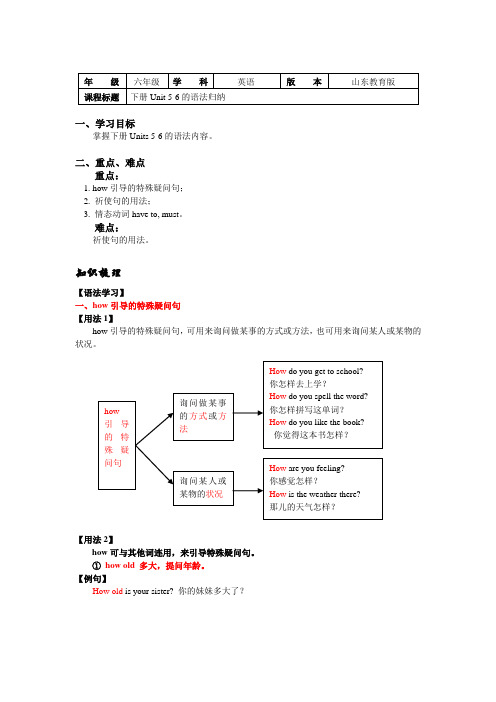
一、学习目标掌握下册Units 5-6的语法内容。
二、重点、难点重点:1. how引导的特殊疑问句;2. 祈使句的用法;3. 情态动词have to, must。
难点:祈使句的用法。
知识梳理【语法学习】一、how引导的特殊疑问句【用法1】how引导的特殊疑问句,可用来询问做某事的方式或方法,也可用来询问某人或某物的状况。
【用法2】how可与其他词连用,来引导特殊疑问句。
①how old 多大,提问年龄。
【例句】How old is your sister? 你的妹妹多大了?②how many 多少,提问可数名词的量。
【例句】How many bananas do you want? 你想要多少香蕉?③how much 多少,提问不可数名词的量。
多少钱;提问价格。
【例句】How much water is there in the bottle? 瓶子里有多少水?How much is the sweater? 这件毛衣多少钱?④how long 多长时间,提问一段时间。
多长,提问物体的长度。
【例句】How long does it take you to get home? 你到家要花费多长时间?How long is the classroom? 这教室多长?⑤how far 多远,提问距离。
【例句】How far is the park from here? 公园离这儿多远?【拓展】①how soon 多快。
【例句】How soon will he be back? 他多快回来?②how often 多久一次,提问频率。
【例句】How often do you go to the movie? 你多久去看一次电影?【考题链接】1. —____ is it to the train station?—About six kilometers.A. How longB. How farC. How muchD. How often答案:B思路分析:根据答语“大约六公里”可知问句询问距离,故排除A, C, D三项。
鲁教版五四制英语六年级下册Unit4单元语法归纳:频率副词总结

鲁教版五四制英语六年级下册Unit4单元语法归纳:频率副词总结单元语法归纳:频率副词总结说起“频率副词”,你可能不太了解。
谈起often,always,usually,sometimes,你一定会脱口而出,它们是一般现在时的“标志词”。
它们是表示频率的副词。
这些词表示经常性动作或情况,不是某一具体动作,常用于一般现在时。
这些频率副词在句子中的位置比较灵活,可以用于句首、句中和句末。
在句中的位置一般在系动词be,情态动词(can,may,must 等)或助动词(do,does 等)之后,行为动词之前。
这些频率副词在表示动作发生的频率时,程度上有所不同,可这样表示:always>usually>often>sometimes1. always意为“总是,一直”。
这是频率最大的词,表示动作重复,状态继续,中间没有间断。
如:Mary is always late for school. 玛丽总是上学迟到。
2. usually意为“通常”,表示习惯动作,频率仅次于always,相当于most often。
表示除个别情况外,基本上没有变化。
如:He usually gets up at 6 o'clock. 他通常6点钟起床。
3. often意为“时常,经常”,表示动作重复,中间有间断,表示发生的频率比usually 要小,但比sometimes要大。
如:I often go to school by bike,but sometimes I go to school by bus. 我经常骑自行车上学,但有时乘公共汽车去。
4. sometimes意为“有时”,表示发生的频率最小。
sometimes 一词在书写时要十分小心,若分开写成some times就成了“好几次,数次”。
如:He has lunch in the factory sometimes. 他有时在工厂吃午饭。
I read this story some times. 这个故事我读过好几次了。
鲁教版本英语小学六年级的下册的语法
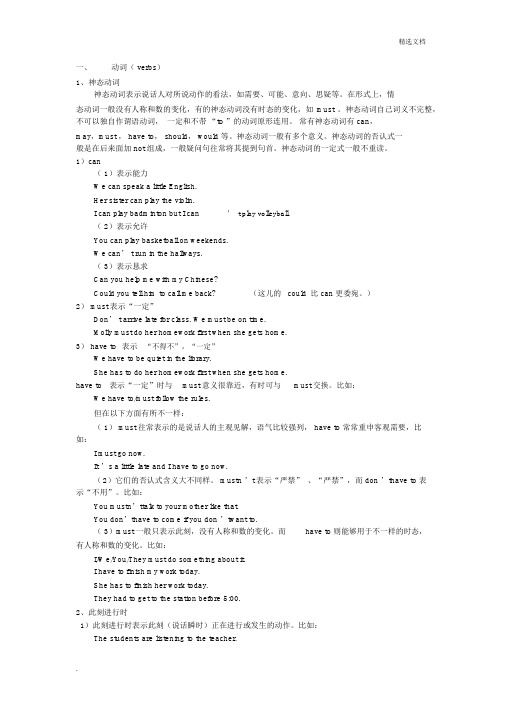
一、动词( verbs)1、神态动词神态动词表示说话人对所说动作的看法,如需要、可能、意向、思疑等。
在形式上,情态动词一般没有人称和数的变化,有的神态动词没有时态的变化,如must 。
神态动词自己词义不完整,不可以独自作谓语动词,一定和不带“to ”的动词原形连用。
常有神态动词有 can,may,must , have to, should, would 等。
神态动词一般有多个意义。
神态动词的否认式一般是在后来面加 not 组成,一般疑问句往常将其提到句首。
神态动词的一定式一般不重读。
1)can( 1)表示能力We can speak a little English.Her sister can play the violin.I can play badminton but I can’ t play volleyball.( 2)表示允许You can play basketball on weekends.We can’ t run in the hallways.( 3)表示恳求Can you help me with my Chinese?Could you tell him to call me back?(这儿的could 比 can 更委宛。
)2) must 表示“一定”Don’ t arrive late for class. We must be on time.Molly must do her homework first when she gets home.3) have to表示“不得不”,“一定”We have to be quiet in the library.She has to do her homework first when she gets home.have to表示“一定”时与must 意义很靠近,有时可与must 交换。
比如:We have to/must follow the rules.但在以下方面有所不一样:( 1) must 往常表示的是说话人的主观见解,语气比较强列, have to 常常重申客观需要,比如:I must go now.It ’s a little late and I have to go now.(2)它们的否认式含义大不同样。
鲁教版六年级下册英语Unit9词组句型语法知识点总结
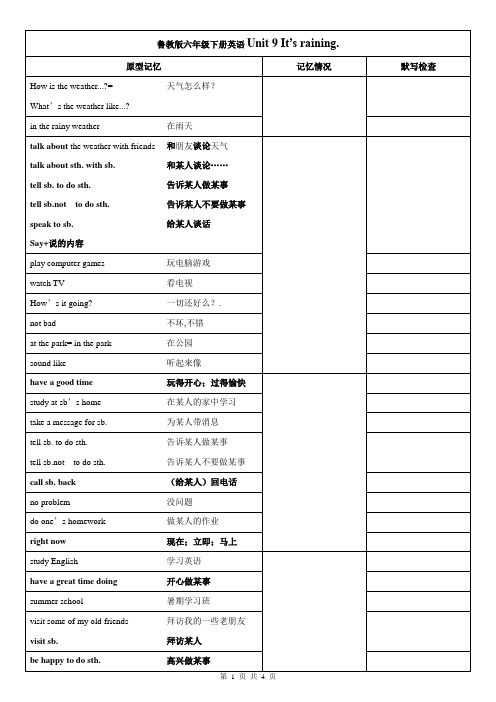
sit by the pool 坐在游泳池边drink orange juice 喝橙汁summer vacation 暑假study hard 努力学习be on vacation 在度假write to sb. 给某人写信in your country 在你的国家next month 下个月for three hours 三个小时wear hats 戴帽子take a photo of sb. 给某人照相speak to sb. 给某人谈话二、句型展示1. Hello,Rick speaking.喂,我是里克。
Hi Rick, It’s Steve.里克你好,我是史蒂夫。
(多用于电话用语)2. —How’s it going? 近来可好?—Not bad, thanks.马马虎虎,谢谢。
3.Sounds like you’re having a good time.听起来你玩得好开心。
4.Could you just tell him to call me back? 你能否叫他给我回个电话?5. She is working here and I'm going to summer school.她在这里上班,而我呢,将要去上博假学习班。
6. ---How's the weather? 天气怎么样?—It's cloudy. /It's sunny. /It's rainy.多云/阳光明媚/天正下雨呢。
7.He’s studying at his friend’s home.他正在朋友家学习呢。
8.I’m having a great time visiting my aunt in Canada.现在我在加令大看望我姑姑,玩得非常开心。
9.The weather here is cool and cloudy,just right for walking.这儿的天气凉爽,正好适宜于散步。
鲁教版五四制英语六年级下册Unit3:重点归纳知识归纳
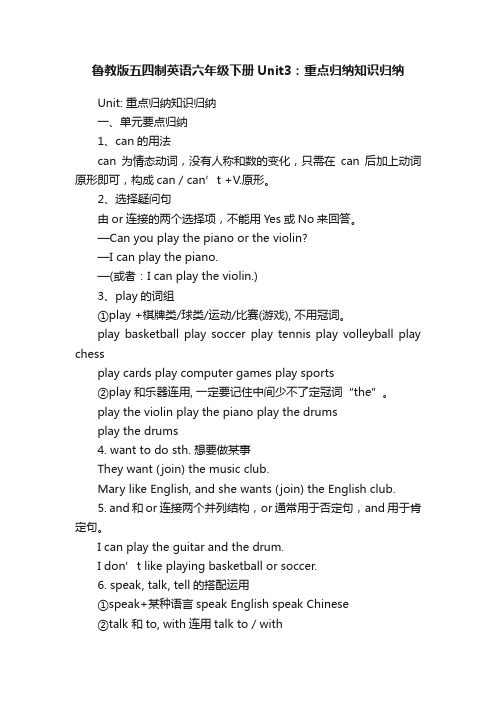
鲁教版五四制英语六年级下册Unit3:重点归纳知识归纳Unit: 重点归纳知识归纳一、单元要点归纳1、can的用法can为情态动词,没有人称和数的变化,只需在can后加上动词原形即可,构成can / can’t +V.原形。
2、选择疑问句由or连接的两个选择项,不能用Yes或No来回答。
—Can you play the piano or the violin?—I can play the piano.—(或者:I can play the violin.)3、play的词组①play +棋牌类/球类/运动/比赛(游戏), 不用冠词。
play basketball play soccer play tennis play volleyball play chessplay cards play computer games play sports②play和乐器连用, 一定要记住中间少不了定冠词“the”。
play the violin play the piano play the drumsplay the drums4. want to do sth. 想要做某事They want (join) the music club.Mary like English, and she wants (join) the English club.5. and和or连接两个并列结构,or通常用于否定句,and用于肯定句。
I can play the guitar and the drum.I don’t like playing basketball or soccer.6. speak, talk, tell的搭配运用①speak+某种语言speak English speak Chinese②talk 和to, with连用talk to / with③tell sb. sth. 告诉某人某事tell me a story tell stories7. be good at 和be good with①be good at=do well in 擅长于…., 在….上做得好,at为介词,后跟ing。
鲁教版五四制英语六年级下册Unit1 【语法专项】:序数词和名词所有格的用法

【语法专项】:序数词和名词所有格的用法一、序数词序数词是表示顺序的数词。
序数词前常加定冠词the。
序数词的词形变化及其缩写形式:1.第1,2,3是独立的特殊形式,first 1st;second 2nd;third 3rd2.从4到19的序数词,是在相应的基数词的词尾加th,特别注意第五、第八、第九、第十二;fourth 4th;fifth 5th;sixth 6th,seventh 7th;eighth 8th;ninth 9th;tenth 10th;eleventh 11th;twelfth 12th3.20到90这些整十的数词,其相应的基数词都是以ty结尾,序数词一般是把基数词词尾的y变成ie,再加th。
twentieth 20th;thirtieth 30th;fortieth 40th;fiftieth 50th;sixtieth 60th;seventieth 70th;eightieth 80th;ninetieth 90th4.其余的两位数,只需将其相应基数词的个位改成序数词。
twentyfirst 21st;thirty-fourth 34th;sixtyninth 69th;ninetythird 93rd巧记基数词变为序数词:一、二、三要牢记,其余后面加th。
th里边有例外,你要格外记明白。
八去t,九去e,ve要用f替。
几十变y为ie,跟着再加th。
几十几只变个位数。
序数词表顺序,一般要加定冠词。
二、名词的所有格在汉语中,我们常用“的”表示某物归谁所有。
如:老师的书;丽萍的尺子等。
英语中的这种所属关系就是名词所有格,相当于汉语中的“的”。
所有格的类型:1.“'s”所有格有生命物体的名词以及表示时间、距离、国家、城市等的名词常用“'s”所有格。
It's twenty minutes' walk.步行二十分钟的路程。
有以下几种加's的情况:a .单数名词后直接加“'s”。
鲁教新版英语六年级下册第六单元知识点
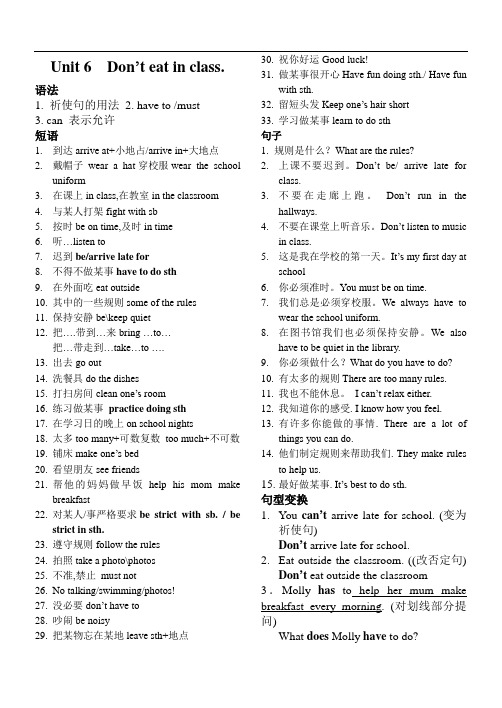
Unit 6 Don’t eat in class.语法1. 祈使句的用法2. have to /must3. can 表示允许短语1.到达arrive at+小地占/arrive in+大地点2.戴帽子wear a hat穿校服wear the schooluniform3.在课上in class,在教室in the classroom4.与某人打架fight with sb5.按时be on time,及时in time6.听…listen to7.迟到be/arrive late for8.不得不做某事have to do sth9.在外面吃eat outside10.其中的一些规则some of the rules11.保持安静be\keep quiet12.把….带到…来bring …to…把…带走到…take…to ….13.出去go out14.洗餐具do the dishes15.打扫房间clean one’s room16.练习做某事practice doing sth17.在学习日的晚上on school nights18.太多too many+可数复数too much+不可数19.铺床make one’s bed20.看望朋友see friends21.帮他的妈妈做早饭help his mom makebreakfast22.对某人/事严格要求be strict with sb. / bestrict in sth.23.遵守规则follow the rules24.拍照take a photo\photos25.不准,禁止must not26.No talking/swimming/photos!27.没必要don’t have to28.吵闹be noisy29.把某物忘在某地leave sth+地点30.祝你好运Good luck!31.做某事很开心Have fun doing sth./ Have funwith sth.32.留短头发Keep one’s hair short33.学习做某事learn to do sth句子1. 规则是什么?What are the rules?2.上课不要迟到。
鲁教版五四制英语六年级下册Unit2 【语法全解】:特殊疑问句精讲
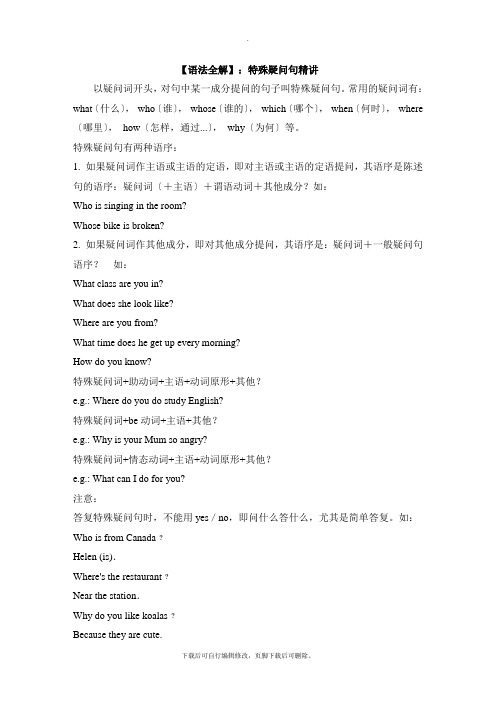
.【语法全解】:特殊疑问句精讲以疑问词开头,对句中某一成分提问的句子叫特殊疑问句。
常用的疑问词有:what〔什么〕,who〔谁〕,whose〔谁的〕,which〔哪个〕,when〔何时〕,where 〔哪里〕,how〔怎样,通过...〕,why〔为何〕等。
特殊疑问句有两种语序:1. 如果疑问词作主语或主语的定语,即对主语或主语的定语提问,其语序是陈述句的语序:疑问词〔+主语〕+谓语动词+其他成分?如:Who is singing in the room?Whose bike is broken?2. 如果疑问词作其他成分,即对其他成分提问,其语序是:疑问词+一般疑问句语序?如:What class are you in?What does she look like?Where are you from?What time does he get up every morning?How do you know?特殊疑问词+助动词+主语+动词原形+其他?e.g.: Where do you do study English?特殊疑问词+be动词+主语+其他?e.g.: Why is your Mum so angry?特殊疑问词+情态动词+主语+动词原形+其他?e.g.: What can I do for you?注意:答复特殊疑问句时,不能用yes/no,即问什么答什么,尤其是简单答复。
如:Who is from Canada﹖Helen (is).Where's the restaurant﹖Near the station.Why do you like koalas﹖Because they are cute.下载后可自行编辑修改,页脚下载后可删除。
- 1、下载文档前请自行甄别文档内容的完整性,平台不提供额外的编辑、内容补充、找答案等附加服务。
- 2、"仅部分预览"的文档,不可在线预览部分如存在完整性等问题,可反馈申请退款(可完整预览的文档不适用该条件!)。
- 3、如文档侵犯您的权益,请联系客服反馈,我们会尽快为您处理(人工客服工作时间:9:00-18:30)。
一、动词(verbs)
1、情态动词
情态动词表示说话人对所说动作的观点,如需要、可能、意愿、怀疑等。
在形式上,情态动词一般没有人称和数的变化,有的情态动词没有时态的变化,如must。
情态动词本身词义不完全,不能单独作谓语动词,必须和不带“to”的动词原形连用。
常见情态动词有can,may,must,have to,should,would等。
情态动词一般有多个意义。
情态动词的否定式一般是在其后面加not构成,一般疑问句通常将其提到句首。
情态动词的肯定式一般不重读。
1)can
(1)表示能力
We can speak a little English.
Her sister can play the violin.
I can play badminton but I can’t play volleyball.
(2)表示许可
You can play basketball on weekends.
We can’t run in the hallways.
(3)表示请求
Can you help me with my Chinese?
Could you tell him to call me back?(这儿的could比can更委婉。
)
2)must表示“必须”
Don’t arrive late for class. We must be on time.
Molly must do her homework first when she gets home.
3)have to表示“不得不”,“必须”
We have to be quiet in the library.
She has to do her homework first when she gets home.
have to表示“必须”时与must意义很接近,有时可与must互换。
例如:We have to/must follow the rules.
但在以下方面有所不同:
(1)must通常表示的是说话人的主观看法,语气比较强列,have to往往强调客观需要,例如:
I must go now.
It’s a little late and I have to go now.
(2)它们的否定式含义大不相同。
mustn’t表示“不准”、“禁止”,而don’t have to表示“不必”。
例如:
You mustn’t talk to your mother like that.
You don’t have to come if you don’t want to.
(3)must一般只表示现在,没有人称和数的变化。
而have to则可以用于不同的时态,有人称和数的变化。
例如:
I/We/You/They must do something about it.
I have to finish my work today.
She has to finish her work today.
They had to get to the station before 5:00.
2、现在进行时
1)现在进行时表示现在(说话瞬间)正在进行或发生的动作。
例如:
The students are listening to the teacher.
He is watching TV now.
现在进行时也可表示当前一段时间内的活动或现阶段正在进行的动作。
例如:
We are working on a farm these days.
I’m reading a history book this month.
2)现在进行时是由助动词be(am/is/are)加动词-ing形式构成的。
以动词work为例,现在进行时的肯定式、否定式、疑问式和简略答语如下:
二、There be结构
There be结构的一般现在时是There is/are。
“There is/are+某物/某人+某地/某时”结构表示“某地或某时有某物或某人”。
这种结构中的there没有实际意义。
句子中的be(is/are)和后面所跟的名词在数方面必须一致。
There be结构的一般现在时基本句型如下:
There is a pen and two books on the desk.
There are two boys and a girl in the room.
三、数词
1、基数词
2、序数词
四、介词
介词一般位于名词或代词前,表示该词与句中其他成分的关系。
介词后面的名词或代词称为介词宾语(若是人称代词,则要用宾格)。
介词和介词宾语合在一起构成介词短语。
1、表示时间的介词
表示时间的介词主要有at,on和in,它们的常见用法如下:
breakfast/class/school。
2、表示地点的介词
表示地点的介词和介词短语很多,如at,in,on,near,next to,in front of,before,under,behind,beside,between,in the front of,in the middle of,at the back of等,其中最常用、最灵活的是at,in和on这三个介词。
比如,“在学校里”可以说in school,也可以说at school。
